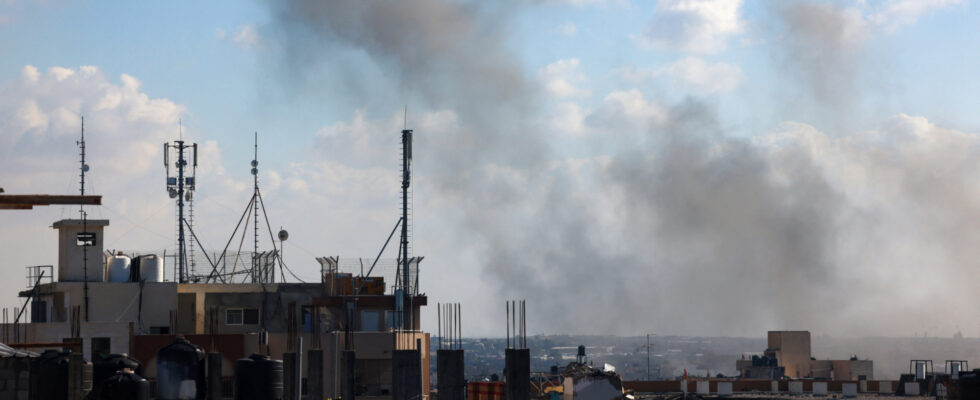The head of American diplomacy Antony Blinken tried on Tuesday during his tour of the Middle East to obtain a truce between Israel and Hamas in Gaza, where Israeli strikes and fighting have still killed more than 100 Palestinians according to the terrorist movement. As the war enters its fifth month on Wednesday, Anthony Blinken, whose country is a close ally of Israel, met President Abdel Fattah al-Sissi in Egypt on Tuesday before traveling to Qatar.
A necessary “regional coordination to achieve a sustainable end”
At the start of his tour on Monday, his fifth since the outbreak of hostilities on October 7, the Secretary of State discussed in Riyadh with Saudi Crown Prince Mohammed bin Salman the necessary “regional cooperation to achieve a lasting end” of the war, according to the State Department. After Qatar, Anthony Blinken must go to Israel, where he must notably insist on the urgency of letting aid enter Gaza, a small overpopulated territory devastated by Israeli bombings and described as an “uninhabitable place of death” according to the UN.
Incessant Israeli strikes again targeted Khan Younes and Rafah, in the south of the besieged territory, on Tuesday, according to an AFP journalist. Hamas reported Tuesday 107 deaths in 24 hours in the Gaza Strip, where the Palestinian movement, considered a terrorist organization by the European Union and the United States, took power in 2007.
The Israeli army has indicated that it is engaged in “close combat” in Khan Younes, a city largely transformed into a field of ruins which it presents as a Hamas stronghold. The army “leaves us no other choice than death or displacement. They killed children, families, destroyed our homes,” says Riham Sharrab, 21, who fled Khan Younes for Rafah further south. . Also in Rafah, Hamas claimed that an Israeli strike had killed six Palestinian police officers in a vehicle. According to witnesses, they were securing the passage of a humanitarian aid truck.
Reminder
The war was triggered on October 7 by an unprecedented attack in Israel by Hamas commandos infiltrated from Gaza, which resulted in the deaths of more than 1,160 people, the majority civilians, according to an AFP count based on data Israeli officials. In response, Israel vowed to destroy Hamas and launched an offensive that left 27,585 dead in Gaza, the vast majority civilians, according to the Hamas health ministry.
At the end of November, a first one-week truce allowed the increased entry of aid, the release of around a hundred hostages, out of the approximately 250 taken to Gaza on October 7, and Palestinian prisoners. According to Israel, 132 hostages are still held in Gaza, of whom 28 are believed to have died.
Discussions on a possible six-week truce
Anthony Blinken and Abdel Fattah al-Sissi discussed “efforts to secure the release of all hostages held by Hamas,” according to the State Department. Anthony Blinken further underlined the United States’ rejection of “any forced displacement of Palestinians from Gaza and its commitment to establishing a Palestinian state that ensures peace and security for Israelis and Palestinians alike.” Israeli Prime Minister Benjamin Netanyahu rejects the idea of a Palestinian state.
Anthony Blinken, who is also due to visit the West Bank, a Palestinian territory occupied by Israel since 1967, supports a truce project by Qatari, American and Egyptian mediators drawn up in Paris at the end of January, which must still be approved by Hamas and Israel.
According to a Hamas source, the project includes a six-week truce during which Israel will have to release 200 to 300 Palestinian prisoners in exchange for 35 to 40 hostages held in Gaza, and 200 to 300 aid trucks will be able to enter each day into the territory. However, Hamas demands a total ceasefire. Israel, for its part, says it will only definitively end its offensive once Hamas has been eliminated and the hostages freed.
Rafah, Israel’s next objective?
Meanwhile, a major humanitarian crisis continues in the Gaza Strip, where entire neighborhoods have been destroyed by Israeli bombings and 1.7 people have been displaced out of the small territory’s approximately 2.4 million inhabitants. More than 1.3 million displaced people are crowded into desperate conditions in Rafah, five times the original population of this city backed by the closed border with Egypt, according to the UN.
Rafah could be Israel’s next objective. On Monday, Israeli Defense Minister Yoav Gallant warned that the army would “reach places where it has not yet fought (…) up to the last stronghold of Hamas, namely Rafah.” “Netanyahu threatens to invade Rafah and uses the presence of Hamas as an excuse (…) Israel will not stop until it has annihilated the people of Gaza,” says Raed al-Bardani, a 32-year-old displaced person. The displaced in Rafah now only have 1.5 to 2 liters of water each per day for drinking, cooking and washing, according to the UN.
Anthony Blinken also spoke in Cairo of the need to “stop attacks by the Houthis (the Yemeni rebels) against merchant ships” in the Red Sea, while the conflict in Gaza has caused strong tensions between on the one hand Israel and its allies, and on the other Iran and allied groups including Lebanese Hezbollah, Iraqi militias and the Houthis. The latter announced on Tuesday that they had targeted American and British ships in new attacks in the Red Sea.
